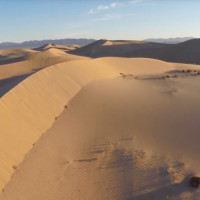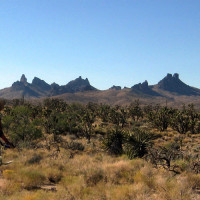
By Heidi Simmons
Tucked back in a canyon, several miles off the windmilled pass of the I-10 corridor, is the Wildlands Conservancy’s Whitewater Preserve.
This 2,800 plus acres between the San Bernardino and San Jacinto Mountains has been completely restored where once existed an old trout farm. Now with well-kept ponds and amenities like covered picnic benches, brick pathways and modern bathrooms, it has been nurtured back to its natural habitat, reclaimed by indigenous flora and fauna.
Senator Dianne Feinstein chose this beautiful slice of the California desert to hold a public hearing for the proposed California Desert National Monuments public meeting.
Hidden out of sight, off the radar, and in the middle of nowhere, it would make sense that people would find it too remote to attend just to express a point of view about land conservation.
But they came. By the busload! Cars, vans and shuttles stretched five miles along the narrow road between the hills that separate counties, cities and ecosystems. Estimates put attendance at over 800!
From LA to Inyo, school children and the elderly, businessmen and naturalists, Indian tribes and private landowners, civic leaders and community organizers, got their say on three proposed monuments: Sand to Snow, Castle Mountains and Mojave Trails.
Introduced to the Senate last February, Feinstein hopes to amend the California Desert Protection Act of 1994. Senate Bill 414 states: “To provide for conservation, enhanced recreation opportunities and development of renewable energy in the California Desert Conservation Area and for other purposes.”
The California Desert Conservation and Recreation Act of 2015 plans to: “Establish or designate national monuments, wilderness areas, a special management area, off-highway vehicle recreation areas, a national scenic area and an area of critical environmental concern; release specified wilderness study areas; adjust national park and preserve boundaries; and specify land withdrawals, exchanges and acquisitions.”
The Sand to Snow National Monument is situated north of Palm Springs and Interstate 10 and includes the Whitewater Preserve, Big Morongo Canyon Preserve, the San Gorgonio Wilderness and the San Bernardino National Forest. This monument, if approved, would skirt the Morongo Reservation, cross highway 62 and border Pipes Canyon Preserve. Also proposed is to include Black Lava Butte/Flat Top Mesa.
Castle Mountain National Monument is situated at the eastern edge of California’s border just above the tip of Nevada’s state line within California’s Mojave National Preserve.
The Mojave Trails National Monument is a convoluted grid spanning over 100 miles west to east and 90 miles north to south. The monument is set between the Twentynine Palms Marine Corps Base and Fort Irwin; skirts the Mojave National Preserve; touches the north-east edge of Joshua Tree National Park; and is just miles from the Arizona border. Famed Route 66 runs through the length of the proposed monument.
All three proposed monuments are in federally managed land and, so far, there are no property transfers designated.
The most controversial and debated region was the Mojave Trails National Monument.
Congressman Paul Cook, Republican from Yucca Valley, represents California’s 8th district, which includes Inyo and Mono counties, Twentynine Palms, most of San Bernardino County and Victorville. Introduced October 1 of this year, Cook has his own bill in the House – H.R. 3668, which conflicts with the Democratic Senator’s SB414. Cook was not present but sent John Sobel, his Chief of Staff.
Cook’s bill states: “To codify in law and expand certain off-highway vehicle recreation areas in the Sate of California, to designate as wilderness certain public lands in the Sate of California administered by the Bureau of Land Management, to expand the Death Valley National Park Wilderness and the San Gorgonio Wilderness in San Bernardino National Forest, to ensure the conservation and necessary management of wildlife in these wilderness areas, to establish the Mojave Trails Special Management Area in the State and for other purposes.”
It would appear to regular folks that these two bills seem to be about the same things. But they are not! This is a debate between government’s control and restrictions of land and the peoples’ right to use it. How hard can it be to meet in the middle? With the way of politics these days in the District of Columbia – it appears to be impossible.
Adding to the controversy, Feinstein has considered using the 1906 Antiquities Act, first used by Theodore Roosevelt, which would allow a presidential proclamation to create national monuments from public lands.
With a simple signature from President Obama, Sand to Snow, Castle Mountains and Mojave Trails would be national monuments no matter what US citizens want. For some, this would be ideal; while for others, it amounts to tyranny!
Some attendees brought hand-made placards and posted them along the road to the venue: “Antiquities Act Removes People’s Rights,” “The People Want a Voice,” “This is Your Land, This is My Land, Not Feinstein’s,” “Yes on Feinstein and No to Cook,” “Memo to President Obama, Yes to Mojave Trails,” “Keep Public Lands Open to the Public.”
Serving not only as the host, but as moderator, Feinstein allowed all voices to be heard. She would not allow boos at those opposed to the monuments, and she gave extra time to disagreeing voices. With wit and charm, she even reigned-in a long-winded, albeit passionate, member on the Dais.
Well organized and managed, speakers were called by name from submitted cards.
They lined up behind two microphones. Everyone had one minute. Timers sat in the front row. Back and forth, the public made their points with precision. People from all over the State shared their perspective to either supporters or detractors. It went on and on for more than two hours.
The voices in favor of the three monuments seemed to out-number those against by two to one. But even those against, like local rock-hounds, miners and off-roaders, declared a love for the California desert and wilderness areas. They, their organizations and the members they represent, wanted to be heard and they wanted their views not only considered, but also included.
As one miner said, “If it isn’t grown, then it’s mined.” He pointed to the cars in the lot, cell phones and tent posts and warned, “If California can’t mine the rare earth minerals, precious metals and microbials, then China will.”
A representative from the Minerals & Mining Advisory Council said: “Shutting down millions and millions of acres of rich geology in the US and California sets the stage for a Chinese cartel.”
A geologist recited a long list of important “iums” from the Periodic Table. He said: “These may not be significant now, but may be essential to our future.”
And for a moment, there was common ground. Everyone present had a genuine concern for California’s future. Wildlife, renewable energy, jobs, open spaces, responsible mining, camping, stargazing, rock-hounding, horseback riding, off-roading and hiking — whatever it is, those who attended the Public Meeting on the Proposed California Desert Monuments all value our great California wilderness.
Other government officials attending included: Mike Connor, U.S. Department of the Interior Deputy Secretary; Robert Bonnie, U.S. Department of Agriculture Under Secretary; John Laird, California Secretary for Natural Resources; Representative Raul Ruiz; Representative Pete Aguilar; James Ramos, San Bernardino County Board of Supervisors Chairman; John Benoit, Riverside County Supervisor.
After the two plus hours of comments and a long day at the preserve that started at 1:00, the Senator thanked everyone again for attending and excused herself leaving a line of speakers yet to be heard by the remaining panel of officials.
As she made her way to the parking lot, stopping for photos and handshakes among a throng of supporters and staff, I asked the Senator if she was pleased with the event, and if she thought the public meeting would make a difference.
While she walked, carefully keeping an eye on the uneven ground, the Senator spoke to me reflecting on all she had heard throughout the day. After she recited the opposition’s strongest points — as if for the first time considering the significance out loud — Senator Feinstein finished by saying, “Yes, I’m confident the bill will pass.”














































